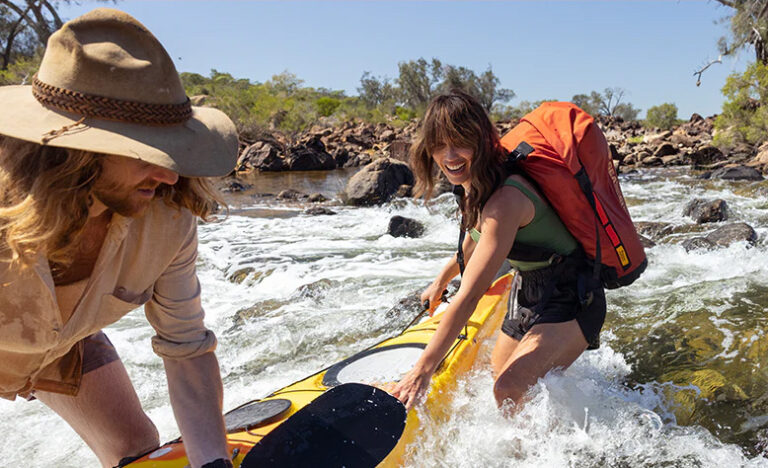By Derrick Knowles, Juliet Sinisterra, & Jon Snyder
We’ve compiled five of the coolest outdoor jobs in the Inland Northwest (and one of the worst). Each of these individuals get to spend time outside on a daily basis and get paid for it–we think that is pretty cool. A lot of them are also making the outdoors safe and accessible for the rest of us.
SERE Specialist (USAF Survival Training Instructor), Tech Sergeant Josh Anderson
Home Base: Fairchild Air Force Base,
Spokane, WA
The 336th Training Group is a tenant unit out at Fairchild Air Force Base, but the sole manager of US Air Force survival training. There are approximately 400 survival training instructors world-wide and 170 are stationed at Fairchild. Named the SERE School (Survival Evasion Resistance Escape), 48 classes are taught each year.
“There is a lot of hands-on training in navigation, the primitive arts [building tools, catching food], when people find themselves isolated they need to know how to procure items from nature. Basically, we train anyone that might be in danger of getting in harm’s way,” says Tech Sgt. Josh Anderson.
The varied temperate zones of the Pacific Northwest, make Fairchild an ideal location for the SERE School. Training for the tropics happens in the Olympic Rainforest, for desert climates at Vantage, for coastal training, Tillamook, Oregon and locally, the Colville National Forest. Trainees graduate with skills ranging from rock climbing to whitewater rafting to the ability to eat live slugs off the Oregon Coast.
“When we train on the coast we eat various mollusks, live clams-it’s a sushi-lovers paradise … to get the maximum effect you have to chew the slugs so you can blow bubbles with their mucous,” says Anderson.
The antics of the trainees at the Oregon Coast balances out the serious nature of survival training. SERE instructors regularly get called overseas to train aircrews for combat, and helicopters at the SERE school regularly assist regional search and rescue operations. Tech Sgt. Anderson never underestimates the need to be prepared when heading out there.
Anderson always carries a mini-survival kit-a tiny Altoids tin, jam-packed with everything from a multiple fire starters to a magnetized needle to Micropure water tablets. The Altoid
tin itself can be used as a reflective mirror to signal for help or to boil water. Items with multiple uses are extremely helpful. Even the ubiquitous plastic garbage bag can end up saving your life by providing shelter from the elements.
“The number one killer is exposure. Most people will die of either hypo- or hyperthermia. The need to survive always happens when you least expect it-a few basic items can make all the difference,” says Anderson.
Training: A two-week wash-out training course in Texas followed by a intensive six-month course. Once an individual is qualified as a SERE Specialist, multiple training opportunities open up to them, such as scuba diving, parachuting or free-fall training.
Gear: As trainers, they get to carry a lot of gear-students do not. Trainers are issues several varieties of backpacks, “Usually these are more
tactically oriented like Blackhawk,” says Anderson. Other items that assist trainers are stoves, water filtration, knives and sleeping bags. “We often make trips to Mountain Gear or
REI to see what would help in the field,” says Anderson.
Pay: $40-50,000 (depends on rank).
Forest Service River Ranger, Linda Hagedorn
Home Base: Slate Creek Ranger Station
(near Riggins, ID)
Spending six to seven months out of the year on one of the west’s premier wilderness rivers sounds more like a vacation than a job. But for Linda Hagedorn, the river is her office from April to November each year. Along with a partner ranger, she represents the Forest Service on the 80-mile Wild and Scenic stretch of the Salmon River through the heart of the Frank Church Wilderness. The work includes checking over 100 camp sites for trash; pulling knapweed and other noxious weeds; and naturalizing beaches in the spirit of the Leave No Trace wilderness ethic.
According to Hagedorn, the hardest part is moving all of the rocks people leave scattered all over the beaches. “Campers are constantly lugging rocks out onto the sand to anchor tarps, tents, and boats, and then we’re responsible for hauling them back off the beaches,” says Hagedorn. As the longest free-flowing river in the lower-48 states, the Salmon River is blessed with an abundance of sandy beaches that Hagedorn is charged with protecting. “One of the neatest things about the Salmon River is all of the white, sand beaches. They’re a natural treasure, and it’s our job to minimize the human impact.”
When they’re not hard at work on the shore, the river rangers are out on the water running rapids and talking with floaters to make sure folks are complying with regulations, practicing basic river safety, and generally keeping out of trouble. After a hard day’s work on the river, it’s another peaceful night at home for Hagedorn, camped out on one of the Salmon’s famed beaches. “I’m lucky enough to be out there three seasons of the year with the wildlife and the river and to see things change,” says Hagedorn. “I think I have the best job in the forest service.”
Training & Education: Experience is everything. Knowledge of river skills, low-impact camping and conservation are required. Wilderness first aid, river rescue training and a recreation degree are a big help.
Tools of the Trade: Rafts, kayaks and camping gear. Satellite phone, first aid gear and a “pin kit” (used to rescue stuck rafts).
Favorite Gear: Heavy-duty vinyl sleeping pads that double as raft seats and cooler protectors and a homemade sling for moving rocks off the beach.
Pay: $10-15 hour for seasonal work.
State Park Ranger (Mountain Bike Ranger & Park Manager), Steve Christensen
Home Base: Mt. Spokane, WA
Steve Christensen along with Washington State Park Rangers Gary Johnson and Clayne Perrins, gets to regularly cruise around Mt. Spokane on a mountain bike, grooming and planning for trails, changing out signs for each season and in general, patrolling the mountain scene.
“I like to be out, I need to know what the trails look like. We groom those trails, plus people need to see us out there,” says Christensen.
Christensen and his team of rangers received bikes through the Washington State Law Enforment Division. “Any state park ranger that wanted one got one-ours tend to be heavier than the standard, we have got rugged trails,” says Christensen.
Christensen admits that he does not get out nearly as much as he would like-inside paperwork duties often require him to be at his
desk, but he does get out at least once a day. During colder months, rangers at
Mt. Spokane can be seen cross-country skiing, downhill skiing or snowmobiling around
the mountain.
Training: Need to complete training at the Ranger Academy in Skagit County or a Washington State Police Academy. As a Washington State Park Ranger you are considered a Law Enforcement agent.
Gear: Giant Trans 3 Mountain Bikes outfitted with lights. “They used to be outfitted with bags on the back but we switched over to what the locals do and now we use daypacks,” says Christensen.
Pay: $50-60,000 annually.
USGS Salmon Surgeon, Jamie Sprandow
Home base: Columbia River Research Laboratory, Cook, WA
More proof that the Endangered Species Act and wildlife recovery can benefit rural economies by creating jobs, wildlife biologist Jaime Sprandow and her team of salmon recovery surgeons make their living implanting tiny tracking devices in juvenile salmon, which helps biologists figure out how the fish are making their way through the gauntlet of damns on the Snake and Columbia Rivers.
The job requires travel up and down the river corridor to remote riverside locations where Sprandow and others work out of rustic trailers that have been converted into salmon recovery laboratories. The work may not be all outdoor fun, but it keeps the salmon surgeons in constant, intimate contact with a Pacific Northwest icon: the Snake River salmon.
Sprandow heads up the operation, leading a team of technicians responsible for surgically implanting radio transmitters into juvenile salmon, which make them trackable via solar powered receivers up and down the river. This hands-on, blue-collar biology work is part of larger salmon recovery efforts in the Snake River Basin. “The data from the receivers helps us see how the fish migrate, how they behave in the river,” says Sprandow. “We’re trying to see how they get by the dams, if they’re going through the turbines or using fish passage devices.”
According to Sprandow, the daily grind goes something like this: capture young fish out of the river, haul them in 5-gallon buckets to the trailer labs, knock the little critters out with anesthetic, carefully make incision and implant transmitters into each slippery patient, sew up the wounds and put them into recovery buckets before releasing the cyber salmon back into the sluggish waters of the Snake and Columbia Rivers.
Training/Education: Two weeks of intense training that includes surgical practice on bananas. No advanced education necessary, although a Biology degree helps.
Gear: surgical gloves (very important for avoiding numb hands while working with anesthetic). Needle drivers, scalpels, suture, lots of 5-gallon buckets, anesthetized water, surgical table and recycled trailers.
Pay: $12-20 an hour for mostly seasonal work.
Eric Ewing, Sports Timer, Milliseconds Sports Timing
Home Base: Spokane, WA
During the week, Eric Ewing is home with his 17-month old twins, but on the weekend, he travels the Pacific Northwest and elsewhere to time sporting events using software developed exclusively for Milliseconds Sports Timing based in Salt Lake City, Utah.
“Milliseconds brought me on board because they were turning down business in the Pacific Northwest. They did not have the crew to do it. My calendar for 2007 is already full for July & August,” says Ewing.
Weekends during the summer, Ewing bounces around between races in Seattle, Spokane, Silver Mountain and Oregon. Race size varies between 100 to 10,000 participants. Once the colder weather arrives, Milliseconds sends Ewing across the country to time events over there. Traveling to new, cool cities is part of the appeal for Ewing.
“The ones I like doing the most, are the ones in cities that I have never been to. I really liked the one [triathlon] I did in Bend, Oregon-the Deschutes Dash,” says Ewing.
Right now, Ewing mostly times triathlons. “Those are the hardest to time. People want to know their integral time,” says Ewing, “they want to know how long it took them to do their swim, how long it took them to get out of their wetsuit and put their shoes on. We can capture transition time.”
Another challenge is impatient competitors. Because Ewing is busy running software during the race, he is not always able to answer everyone’s questions immediately. As a result, he tries to keep a low profile during races, hiding behind the walls of his portable ten by ten tent. Still, Ewing enjoys the service he provides.
“I find a lot of joy in racers in getting their results up so quick. When you are able to hand them [race promoters] unofficial results about a half hour into the race, they can’t believe it. They are used to this army of volunteers doing hand calculations.”
Milliseconds uses reusable chips that are placed in a neoprene padded strap that is wrapped around the racer’s ankle. Ewing recently timed the Bare Buns Fun Run-the annual nudist run held in July at Loon Lake. “They weren’t completely nude,” says Ewing, “they had their ankle straps on.”
Training: “The first thing you would want is computer skills-specifically data base and spreadsheets. We custom write our own software. Being able to know your way around the computer. Having some background in how sporting events work. I have an easier time, since I know what the promoters are going through.”
Gear: Three components are needed. The racer has to have the chip on the ankle, track-side boxes that pick up the signal, and the computer-a Powerbook G4 Laptop.
Pay: In the “$25K Range.” “I’m not getting rich doing what I do. The fact that I love my job is just
as important to me as the money.” //
Cruel Jon
When OTM first learned someone had a gig diving for golf balls at the Coeur d’Alene Resort we thought it was shoo-in for our cool jobs feature.
And then we actually spoke to the golf ball diver.
Turns out that “cool” is nowhere to be found on the long list of adjectives Bob Hamilton uses to describe his job. Dirty, disgusting, slimy, and cold are more like it.
“It’s brutal work,” says Hamilton. “That’s not water I’m diving into.”
The liquid in the golf course water traps is mix of pesticides, herbicides, fertilizer and sewage, that is mucky with stagnation and ice-cold even in the middle of summer because it is fed with tap water. When Hamilton first started golf ball diving he contracted a virus he couldn’t get rid of. That led to acquiring a full environmentally-sealed wetsuit. Which was great, but it didn’t stop the leaches.
Hamilton doesn’t know what makes leaches thrive in water traps but times he’s seen them so thick along the bottom that “they look like grass.” With a conventional scuba mask Hamilton found he still had a couple inches on his face exposed. One day he went down and came up with two leaches on those two inches. That’s when he decided it was time for the environmentally-sealed, positive pressure, full face mask.
Now he dives with $5,000 worth of commercial equipment that weighs around a hundred pounds. “Water does not touch me,” says Hamilton.
Hamilton is a firefighter, who used to own a scuba shop, is master scuba diving instructor, and has worked in water search and rescue. He says you need smart hands to dive for golf balls because you get paid by the ball and the better you can feel for balls in the darkness the more you can get.
The golf courses have a contract Hamilton where they get a percentage of the proceeds he gets from selling the balls. After retrieving them he has to clean them and find buyers. He sells the balls bulk and these days most of them end up in Taiwan or Europe. Even with all the Inland Northwest golf courses under contract he says he wouldn’t be able to make a living off of golf balls diving by itself.
Though he’s had partners dive with him from time to time they rarely come back for a second dive. “I would love to have the help,” says Hamilton. Think you have what it takes? You can contact him through the Coeur D’Alene Resort.
Training: Novice scuba divers can get started with classes at local shops.
Gear: Full Face Positive Pressure Mask made by Interspiro.
Pay: “I’m happy if I get five cents a ball.” You do the math.













